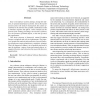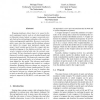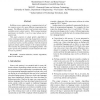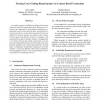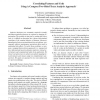CSMR
2005
IEEE
14 years 8 months ago
2005
IEEE
Well-designed object-oriented programs typically consist of a few key classes that work tightly together to provide the bulk of the functionality. As such, these key classes are e...
CSMR
2005
IEEE
14 years 8 months ago
2005
IEEE
Real world software systems undergo, during their lifetime, to repeated maintenance activities. Due to the market pressure and to the need for having back the system operational i...
CSMR
2005
IEEE
14 years 8 months ago
2005
IEEE
Wrapping databases allows them to be reused in formerly unplanned contexts, such as web-based applications or federated systems. Indeed, a wrapper can provide external clients of ...
CSMR
2005
IEEE
14 years 8 months ago
2005
IEEE
Data mining is a technology recently used in support of software maintenance in various contexts. Our works focuses on achieving a high level understanding of Java systems without...
CSMR
2005
IEEE
14 years 8 months ago
2005
IEEE
Building reverse engineering or reengineering tools often requires parsers for many different programming languages. The diffusion of dialects and variants makes many available pa...
CSMR
2005
IEEE
14 years 8 months ago
2005
IEEE
Product software is constantly evolving through extensions, maintenance, changing requirements, changes in configuration settings, and changing licensing information. Managing ev...
CSMR
2005
IEEE
14 years 8 months ago
2005
IEEE
In complex systems, it is difficult to identify which system element is involved in which requirement. In this article, we present a new approach for expressing and validating a ...
CSMR
2005
IEEE
14 years 8 months ago
2005
IEEE
Impact analysis is the process of determining the effect, or impact, of a change to a software system. Dynamic impact analysis uses data obtained from executing a program to perfo...
CSMR
2005
IEEE
14 years 8 months ago
2005
IEEE
Software developers are constantly required to modify and adapt application features in response to changing requirements. The problem is that just by reading the source code, it ...
CSMR
2005
IEEE
14 years 8 months ago
2005
IEEE
In this paper, we discuss experiences gained during evaluation of the maintainability of a reference architecture in use at Oc´e, one of the world’s leading copier manufacturer...

